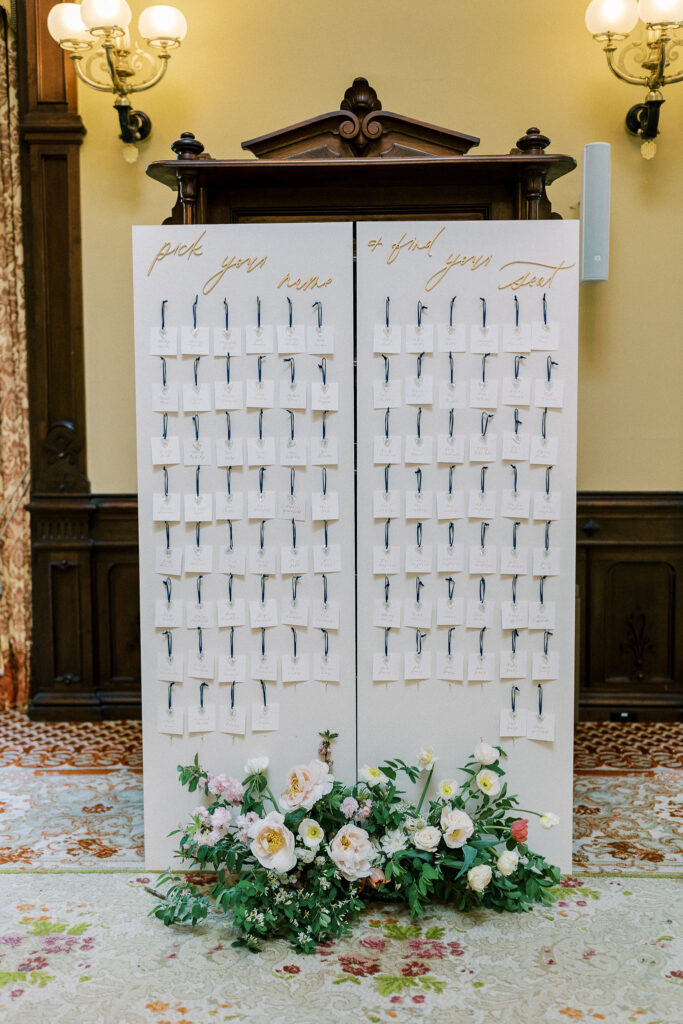Wedding Signage: What’s Needed and What’s Optional
Wedding signage plays a crucial role in setting the tone for your big day while ensuring guests stay informed and organized. Some signs, like a seating chart or table numbers, are essential for smooth event flow. Others, such as a welcome sign or memory table display, add charm and personality but aren’t strictly necessary. The key is understanding the difference between functional and decorative signage. Necessary signage handles logistics, while optional signage enhances the atmosphere and reflects your style. As a Hudson Valley wedding planner, I help couples prioritize their signage needs based on their vision, budget, and venue. This guide will walk you through the must-haves and nice-to-haves to create the perfect balance for your wedding day.

Seating Chart / Escort Card Sign



A seating chart or escort card sign is essential for directing guests to their seats at the reception. It ensures everyone knows where to sit, preventing confusion or awkward moments. As a Hudson Valley wedding planner, I often recommend creative displays like a floral-framed mirror, calligraphed wood board, or an escort card wall. These options blend functionality with style, allowing you to showcase your personality while keeping the reception organized.
Wedding Invitations



Wedding invitations set the tone for your big day and communicate essential details. From the date and location to the dress code, invitations guide guests in preparing for your celebration. They also offer a sneak peek into your wedding theme through colors and designs. Without clear invitations, guests may miss important details. As a Hudson Valley wedding planner, I always stress the importance of cohesive and timely invitations.
Reserved Signs For Ceremony Seats


Reserved seating signs ensure key guests, such as family members or the wedding party, have designated spots at the ceremony. These signs help avoid confusion and make VIP guests feel appreciated. Placing these signs strategically also ensures your loved ones have the best view of the ceremony.
Table Numbers



Table numbers are a must for guiding guests to their seats. They help maintain order and streamline meal service during the reception. Pairing table numbers with your wedding décor adds a cohesive touch. Whether you choose minimalist numbers or ornate designs, they play a key role in keeping the evening on track.
Signature Cocktail Signs


Highlighting signature cocktails with stylish signage adds a personalized touch to your wedding. These signs inform guests of your special creations and encourage them to try something unique. A beautifully designed cocktail sign can serve as a conversation starter and enhance the bar’s visual appeal.

Card Box Sign



A card box sign is optional but helpful if the design blends into your décor. It ensures guests know where to place cards or monetary gifts. As a Hudson Valley wedding planner, I suggest incorporating this sign if your card box isn’t immediately recognizable.
Save The Date


Save the dates are useful for giving guests advanced notice of your wedding. They’re especially helpful for destination weddings or busy seasons. However, if your guest list is local or invitations are sent early, save the dates can be skipped.
Ceremony Programs


Ceremony programs enhance the guest experience by outlining the order of events and explaining traditions. However, they are not essential. A single reusable display board can be an eco-friendly alternative, providing the same information without additional paper.
Guest Book Sign


A guest book sign is optional but can clarify how to participate, especially if you’re using a unique setup like a photo booth or Polaroid station. Traditional guest books are self-explanatory, but a sign can add style and guide guests on what to do.
Amenity Basket Sign

Amenity basket signs are thoughtful but unnecessary. Guests will typically recognize the basket’s purpose without direction. If the basket includes unusual items, a small sign can provide clarification.
Welcome Sign



A welcome sign adds a personal touch by greeting guests as they arrive. While not essential, it helps set the tone for the day and enhances the venue’s entryway. As a Hudson Valley wedding planner, I recommend welcome signs for larger venues where guests may need extra guidance.
Bar Menu Sign

Bar menu signs showcase drink options, especially if you have a curated list or signature cocktails. While not necessary, they are a helpful addition for guests who want to explore the offerings without asking the bartender.
Menu Sign

Individual menu cards are optional but add an elegant touch to the dining experience. For buffet-style receptions, a single menu board may be sufficient. Decide based on your budget and the formality of your event.
Unplugged Ceremony Sign


An unplugged ceremony sign asks guests to refrain from using phones or cameras. This ensures everyone stays present during your vows. While optional, it’s an excellent way to create an intimate atmosphere and avoid distractions..
Memory Table Sign


A memory table honors loved ones who have passed. Adding a sign explains the display’s significance, but it’s not required. Many guests will understand the meaning without one, making this a purely personal choice.
Wedding signage is a blend of practicality and personality, ensuring your day is both seamless and stylish. As a trusted Hudson Valley wedding planner, I help couples prioritize their signage to balance function and flair. Whether you choose simple signs or elaborate designs, every detail contributes to the story of your wedding day.
For more tips on creating the perfect wedding, explore our ultimate wedding planning checklist or contact us for personalized planning services. Let’s make your day unforgettable!
PS: Check out our other blog post about how to address plus ones on your wedding invitations!